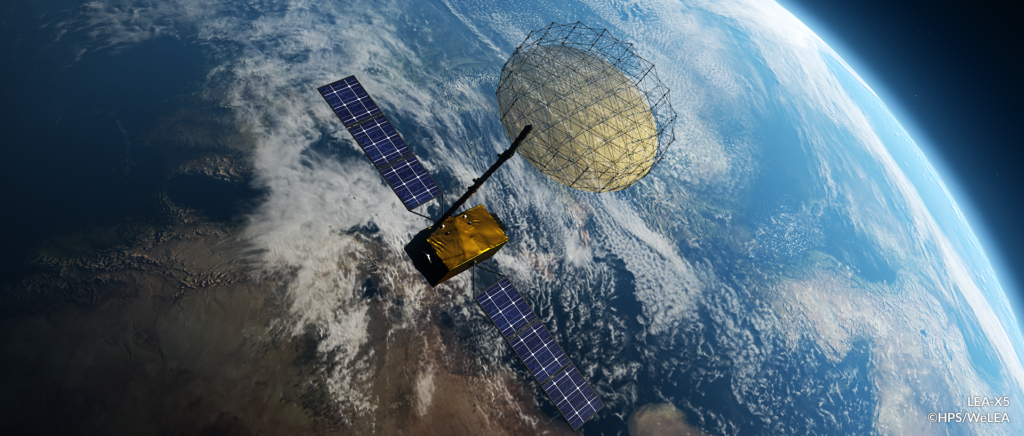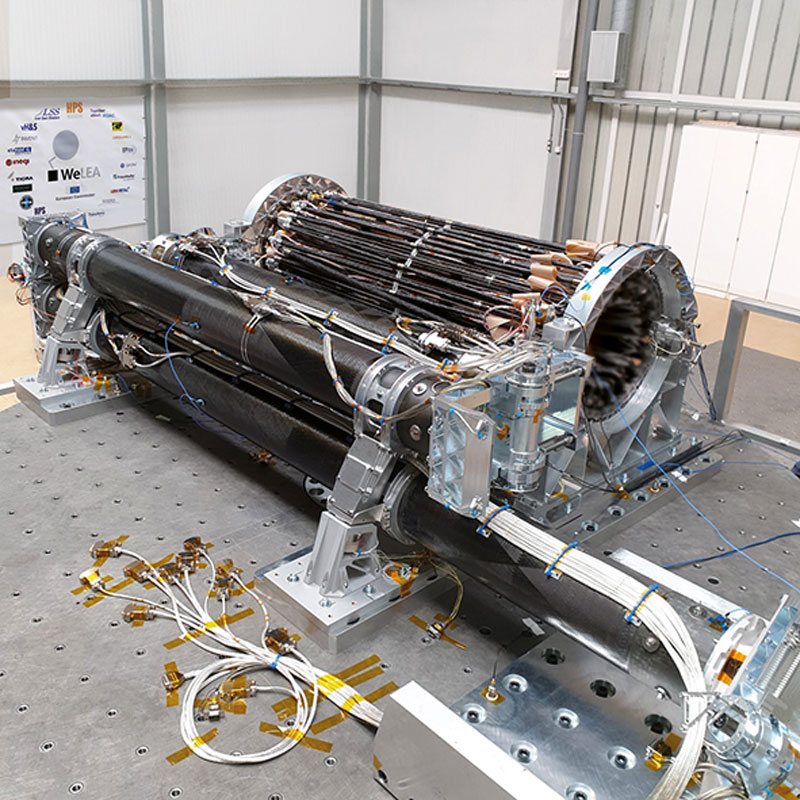Juli 2021
LEA-X5: New Movie on the completion of the European 5m X-band LDRS
Gladly we announce with a new 20-minutes-movie the completion of the H2020-development „LEA-X5“, the 5m class European Large Deployable Reflector Subsystem (LDRS) operating in X-band.
The film itself is of course showing recent environmental and deployment tests, but it is mainly about PEOPLE, who are space engineers and space enthusiasts, and what they can achieve with combined powers and brains. These people, together with the enablers European Commission and European Space Agency, are making the achievement of „European Non-dependance“ happen.
LEA-X5 is a full LDRS-Subsystem (lead by HPS, Germany) and comprises the
- 5m diameter X-band reflector assembly (lead by LSS, Germany)
- the 5m long deployable arm assembly (lead by HPS, Germany),
- hinges & HDRMs (RUAG, DE),
- deployment electronics (vH&S, DE),
- thermal hardware (HPS/FHP).
Further partners of the H2020-consortium have been: INVENT (DE), FHP (PT), INEGI (PT), TICRA (DK), LUMA (SW), HPTEX (DE), ARQUIMEA(SP), HPS (RO), ETAMAX (DE), WSS (DE), ONERA (FR), TAS (FR), OHB (DE), Airbus (DE).
Most of the consortium members are introduced in the movie, inluding many interviews.
Take your time and enjoy the spirit of doing big things: LEA-X5 – European 5m X-band LDRS Completed (Final Report 06/2021) – YouTube
Best regards,
Your WeLEA-Consortium

März 2021
Europas innovative entfaltbare Antennentechnologie nimmt die nächste Hürde
Mit dem soeben bei INEGI erfolgreich abgeschlossenen Test des Deployable Assembly Arm (DAA), der die Deployable Reflector Assembly (DRA) mit dem Satelliten verbindet, hat das europäische LEA-Konsortium unter der Leitung von HPS die nächste Hürde bei der technischen Realisierung von Europas neuer Antennentechnologie genommen.
Der 5 Meter lange DAA besteht aus drei Gelenkmechanismen und zwei HDRMs (beide von RUAG Space Deutschland), Auslösemechanismen (von Arquimea, Spanien), drei CFK-Rohrsegmenten (von INVENT, Deutschland), Metallbeschlägen (teilweise von HPS Rumänien) und einer Deployment Control Electronics & EGSE (von Hoerner & Sulger). Fokus der Tests war einerseits die Verifikation eines gesamten Entfaltzyklus (dauert ganze 25 min.), andererseits die Verifikation der hoher Ausrichtgenauigkeit nach der Entwfaltung, sowie die Validierung der im Vorfeld erstellten thermo-elastischen mathematischen Modelle.
INEGI (Portugal) ist der Hauptpartner für den Arm-Entfaltungstest und ein guter Partner von HPS seit nunmehr über 13 Jahren. INEGI war verantwortlich für den 0-g-Simulationsprüfstand und den thermo-elastischen Verformungsprüfstand. Trotz der Pandemie und aller Einschränkungen konnten die Teams diesen Fortschritt mit höchster Motivation und engstem Kontakt zwischen INEGI/HPS-team vor Ort in Porto und den HPS-Ingenieuren in Deutschland bewältigen. HPS ist verantwortlich für die DAA und auch für das Umsetzungsmanagement der gesamten LEA-Aktivität. Das gesamte LEA-Team umfasst 15 Partner aus 7 Ländern; das Programm startete im Rahmen von H2020 im November 2017. Der Arm-Entfaltungstest und der TED-Test (thermoelastische Verformung) war einer der letzten Tests dieser H2020-Aktivität.
Der nächste Schritt – der noch im März beginnt – ist der Umwelttest (Vibration und thermisches Vakuum) des kompletten LDR-Subsystems (Reflektor, Arm und HDRM, alles miteinander verschraubt), der bei INTA in Madrid, Spanien, durchgeführt wird.
„LEA-X5“ (5m Reflektordurchmesser, 5m Armlänge, X-Band-Anwendung für Erdbeobachtung und Telekommunikation) wird inzwischen als eine der vorbereitenden Technologieentwicklungen für die aktuelle Copernicus CIMR-Mission gesehen.

März 2021
Arm and Reflector of LEA-X5 Successfully Mated to Form Complete Subsystem
Fifteen companies – mostly SMEs – from seven countries and one goal: a deployable 5-meter X-band-antenna as a preliminary development for the CIMR project, developed under the European H2020 program (2017-2021). For the first time ever, such a complete subsystem (HPS) has now been successfully assembled in Europe from the reflector- (LSS) and arm- (HPS) assemblies. Previously, the test deployment of the arm and reflector – each individually – had already been successfully passed.
LEA-X5-Subsystem is now at the premises of the consortium´s highly reliable test partner INTA in Spain, where vibration tests for the subsystem are on the agenda in the presence of the LSS- and HPS-teams. In a third round of testing, the subsystem will have to prove itself capable of withstanding the conditions of the thermal chamber.
The next complete subsystem-hardware in this context – the CIMR LDRS-EQM – will be assembled end 2023.
With the key technology behind LEA-X5, the continent is decisively expanding its independence from non-European sources.

